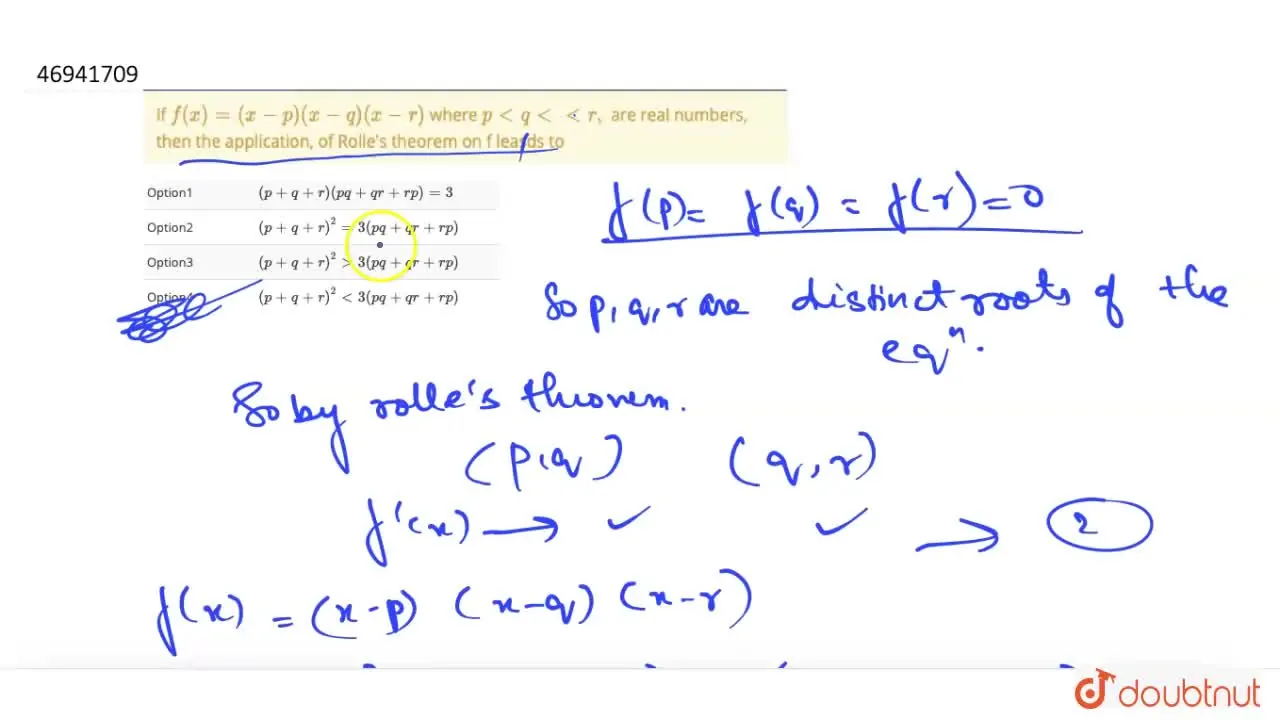If f(x)=(x−p)(x−q)(x−r) where p<q<<r, are real numbers, then the application, of Rolle's theorem on f leasds to
(p+q+r)(pq+qr+rp)=3
(p+q+r)2=3(pq+qr+rp)
(p+q+r)2>3(pq+qr+rp)
(p+q+r)2<3(pq+qr+rp)
The correct Answer is:C
We have,
f(x)=(x−p)(x−q)(x−r)
⇒f(p)=0=f(q)=f(r)
⇒p,q r and there distinct real roots of f(x)=0
so, by Rolle's theorem, f'(x) has one real root in the interval (p,q) and other in the interval, (q,r). Thus, f'(x) has two distinct real roots.
Now,
f(x)=(x−p)(x−q)(x−r)
⇒f(x)=x3−x2(p+q+r)+x(pq+qr+rp)−pqr
⇒f'(x)=3x2−2(p+q+r)x+(pq+qr+rp)
As f'(x) has distinct real roots.
∴4(p+q+r)2−12(pq+qr+rp)<0
⇒(p+q+r)23(pq+qr+rp)
Related Playlists
- BOOK - OBJECTIVE RD SHARMACHAPTER - MEAN VALUE THEOREMSEXERCISE - Section II - Assertion Reason Type4videos
MEAN VALUE THEOREMS
- BOOK - OBJECTIVE RD SHARMACHAPTER - MEAN VALUE THEOREMSEXERCISE - Exercise28videos
MEAN VALUE THEOREMS
- BOOK - OBJECTIVE RD SHARMACHAPTER - MEAN VALUE THEOREMSEXERCISE - Exercise28videos
MEAN VALUE THEOREMS
- BOOK - OBJECTIVE RD SHARMACHAPTER - MATRICESEXERCISE - Chapter Test30videos
MATRICES
- BOOK - OBJECTIVE RD SHARMACHAPTER - PAIR OF STRAIGHT LINESEXERCISE - Chapter Test19videos
PAIR OF STRAIGHT LINES
Similar Questions
Discuss the applicability of Rolles theorem for f(x)=tanx on [0, π]
View SolutionRolles theorem is applicable for
View SolutionIf f(x)=px+q and f(f(f(x)))=8x+21, where p and q are real numbers, then p+q equals
View SolutionFor the function f(x)=ecosx, Rolle's theorem is
View SolutionGiven f(x)=ax+b and f(f(f(x)))=27x+13 where a and b are real numbers then
View SolutionDiscuss the applicability of Rolle's theorem, when :
f(x)=x½ on [−1,1]View SolutionVerify Rolle's theorem for f(x)=x,x∈[1,2].
View SolutionDiscuss the applicability of Rolle's theorem, when :
f(x)=cos1xon[−1,1]View SolutionDiscuss the applicability of Rolles theorem for the function f(x)=x2/3 on [−1, 1]
View SolutionConsider the function f(x)=e−2xsin2x over the interval (0,π2). A real number c∈(0,π2), as guaranteed by Rolle's theorem such that f'(c)=0, is
View Solution


